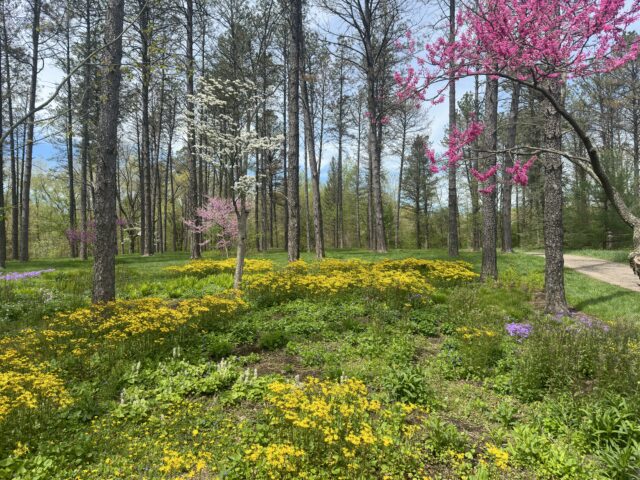New Study Reveals Overlooked Driver of Biodiversity Across Landscapes: Conditions During Plant Establishment
November 2, 2023

How can so many different species coexist in an ecosystem? In a new study published in Ecology, researchers from Holden Forests & Gardens, the University of California, Davis, and Southern Oregon University reveal an under-appreciated driver of diversity across landscapes: the conditions during plant establishment, or year effects. The results have important implications for our understanding of biodiversity patterns and for the management of restoration efforts.
Researchers have known for a number of years that a planted community, like a restored grassland, can be highly impacted by the specific conditions that occur during planting. Conditions like rainfall, temperature, how hungry the local rodents are for seeds that season, and more can not only alter which plants grow in the first year, but also have lasting effects on what species persist and thrive in that place.
“Time is really an underappreciated factor in ecology,” says Katie Stuble, scientist at Holden Forests & Gardens. “We assume that ecological factors such as biodiversity and community composition will vary from site to site, but tend not to give equal consideration to how variation in conditions across time has the potential to shape communities.”
Previous studies focused on how year of establishment might affect ecosystems on a local scale. However, until now, it was unknown how these effects would scale up to influence the patterns of biodiversity across a landscape.
To address this gap, the researchers established a series of what they call “grassland mesocosms” — think miniature ecosystems — at three different sites over a five-year period. Each mesocosm was planted with plant species that were either native perennials (species that live for multiple years) or non-native annuals (species that live only one year), with the planting methods and species otherwise held constant year over year. The researchers then monitored the mesocosms for four to eight years to see how the year of establishment and the site location influenced the composition and diversity of the plant communities.
They found that the perennial species responded to planting year conditions, meaning planting the same mix of perennials, even at the same site, resulted in different plant communities depending on the year. That means planting the same mix in different different years actually increased the diversity of the landscape as a whole.
But for annual species, the trends flipped. Annual communities looked different at different sites, presumably due to different local conditions like soils, but within sites, planting year effects were a wash.
The findings have important implications for our understanding of the drivers of biodiversity. They show that the way in which plant communities are established and the timing of establishment can have a major impact on the patterns of biodiversity across a landscape. This is especially true in systems dominated by perennial species, where the year of establishment can influence the diversity of plant communities for many years to come.
“It’s been really interesting to see how timing can shape communities, and ultimately increase biodiversity across the landscape,” says Stuble.
By understanding the importance of year effects on plant communities, land managers can better design and implement restoration projects to promote diversity and long-term resilience. For example, they can consider planting in different years, or establishing mesocosms at different sites, to promote a greater diversity of plant communities across a landscape. By improving our understanding of the key drivers of biodiversity, this study provides valuable insights for managing restoration efforts and promoting diverse ecosystems.
—
Citation: Werner, Chayya et al. “Year effects drive beta diversity, but unevenly across plant community types.” Ecology.
About Holden Forests & Gardens: Holden Forests & Gardens is made up of two of Northeast Ohio’s most important environmental and cultural institutions — the Holden Arboretum and Cleveland Botanical Garden — whose mission is to connect people with the wonder, beauty, and value of trees and plants, to inspire action for healthy communities. One of the largest public gardens in the country, Holden Forests & Gardens has 18,000 member households and an annual attendance of nearly 350,000 for whom we strive to provide inspirational and educational visitor experiences. For more information, visit holdenfg.org.
Media Contact:
Anna Funk
Science Communications Specialist
Holden Forests & Gardens
afunk@holdenfg.org
Corresponding Author:
Katie Stuble
Scientist
Holden Forests & Gardens
@HFandG
kstuble@holdenfg.org

Anna Funk, PhD
Science Communications Specialist
Anna Funk is the Science Communication Specialist for Holden Forests & Gardens. She earned her Ph.D. studying prairie restoration before leaving the research world to help tell scientists’ stories. Today, she wears many hats, working as a writer, editor, journalist and more — anything that lets her share her appreciation of science and its impact with others.











